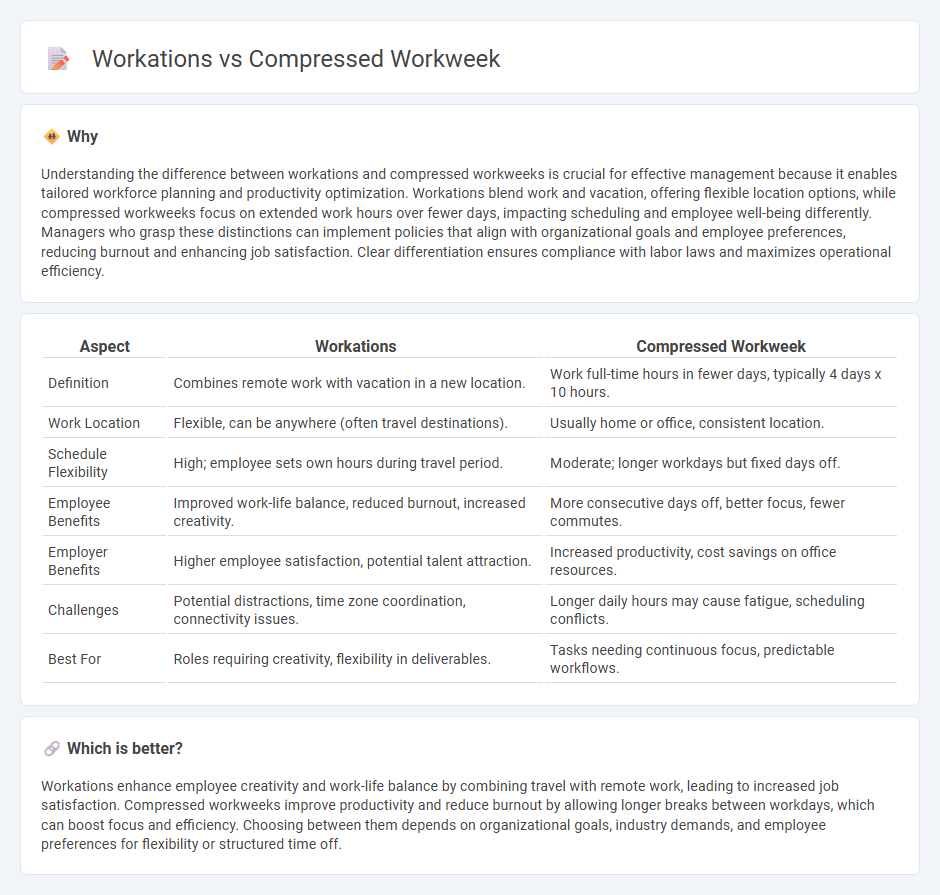
Workations combine remote work with vacation settings, enhancing employee creativity and reducing burnout by blending productivity with relaxation. Compressed workweeks condense full-time hours into fewer days, improving work-life balance and increasing focus through extended off-time periods. Explore these innovative management strategies to optimize workforce efficiency and employee satisfaction.
Why it is important
Understanding the difference between workations and compressed workweeks is crucial for effective management because it enables tailored workforce planning and productivity optimization. Workations blend work and vacation, offering flexible location options, while compressed workweeks focus on extended work hours over fewer days, impacting scheduling and employee well-being differently. Managers who grasp these distinctions can implement policies that align with organizational goals and employee preferences, reducing burnout and enhancing job satisfaction. Clear differentiation ensures compliance with labor laws and maximizes operational efficiency.
Comparison Table
| Aspect | Workations | Compressed Workweek |
|---|---|---|
| Definition | Combines remote work with vacation in a new location. | Work full-time hours in fewer days, typically 4 days x 10 hours. |
| Work Location | Flexible, can be anywhere (often travel destinations). | Usually home or office, consistent location. |
| Schedule Flexibility | High; employee sets own hours during travel period. | Moderate; longer workdays but fixed days off. |
| Employee Benefits | Improved work-life balance, reduced burnout, increased creativity. | More consecutive days off, better focus, fewer commutes. |
| Employer Benefits | Higher employee satisfaction, potential talent attraction. | Increased productivity, cost savings on office resources. |
| Challenges | Potential distractions, time zone coordination, connectivity issues. | Longer daily hours may cause fatigue, scheduling conflicts. |
| Best For | Roles requiring creativity, flexibility in deliverables. | Tasks needing continuous focus, predictable workflows. |
Which is better?
Workations enhance employee creativity and work-life balance by combining travel with remote work, leading to increased job satisfaction. Compressed workweeks improve productivity and reduce burnout by allowing longer breaks between workdays, which can boost focus and efficiency. Choosing between them depends on organizational goals, industry demands, and employee preferences for flexibility or structured time off.
Connection
Workations and compressed workweeks both enhance employee productivity and work-life balance by restructuring traditional work schedules. Workations allow employees to work remotely from vacation destinations, leveraging flexible time management, while compressed workweeks reduce the number of workdays by extending daily hours, creating longer consecutive rest periods. Integrating these strategies fosters employee satisfaction and reduces burnout, aligning with modern management practices focused on flexibility and efficiency.
Key Terms
Flexibility
A compressed workweek condenses full-time hours into fewer days, offering employees extended weekends and concentrated work periods that enhance work-life balance and reduce commuting time. Workations combine remote work with travel, allowing professionals to maintain productivity while exploring new environments, promoting mental wellness and creative inspiration. Explore how these flexible work models can transform your professional and personal life.
Productivity
A compressed workweek, characterized by longer workdays and fewer workdays per week, boosts productivity by enhancing focus and reducing commute times. Workations combine work with travel, offering mental refreshment that can lead to increased creativity but may face challenges in maintaining consistent output. Discover which approach aligns best with your productivity goals and work style for optimal results.
Work-life Balance
Compressed workweeks concentrate work hours into fewer days, enhancing personal time and reducing commute stress, thereby promoting a healthier work-life balance. Workations blend remote work with leisure travel, offering flexibility and mental rejuvenation, which can boost productivity and overall well-being. Discover how these innovative work models can transform your approach to balancing career and personal life.
Source and External Links
Compressed Workweek: What Is It and Should Your Company Use It? - This article explores what a compressed workweek is, its common types, and its implementation in various businesses.
Compressed Workweek: Advantages and Disadvantages | Indeed.com - This resource discusses the advantages and disadvantages of compressed workweeks, including different schedule options and their impact on work-life balance.
Pros and Cons of a Compressed Work Schedule - This page details the pros and cons of compressed work schedules, focusing on popular arrangements like the 4/10 schedule and the 9/80 schedule.
 dowidth.com
dowidth.com